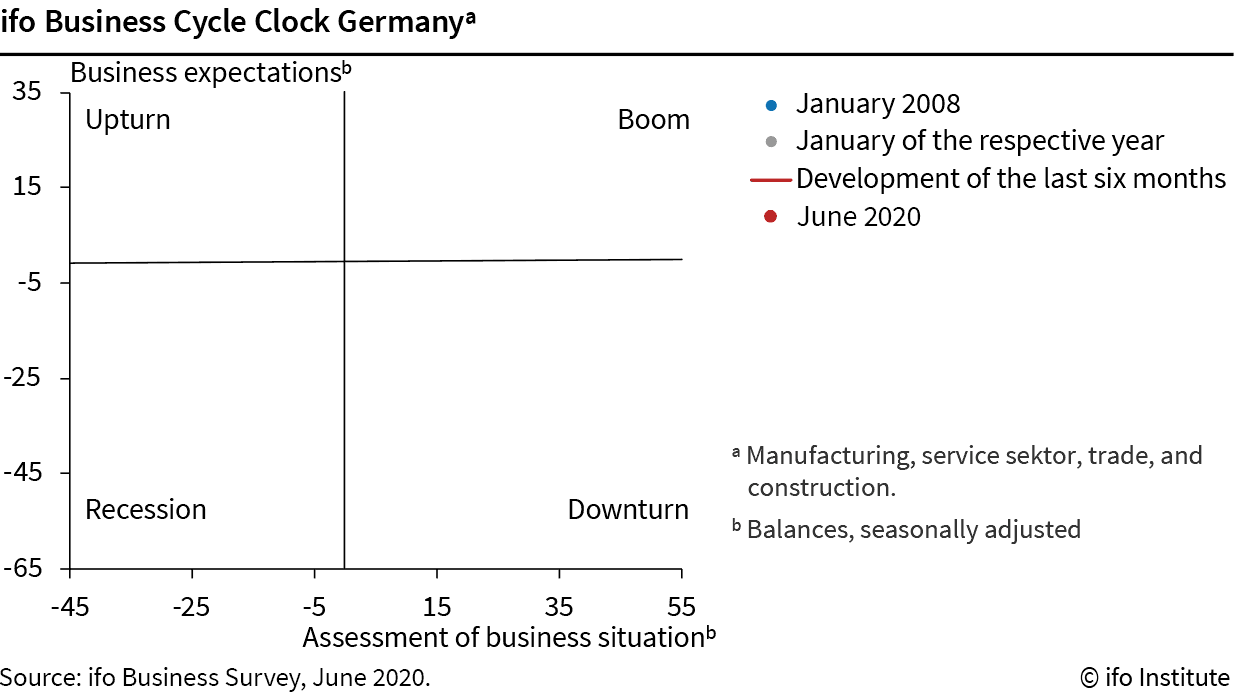ifo Business Climate Index Rises Strongly (June 2020)
Sentiment among German companies has brightened further. The ifo Business Climate Index rose from 79.7 points (seasonally adjusted) in May to 86.2 points in June. This is the strongest increase ever recorded. Companies’ assessments of their current situation were somewhat better. Moreover, their expectations leaped higher. German business sees light at the end of the tunnel.
Download

In manufacturing, the Business Climate Index again rose significantly. This was due to notably improved expectations among industrial companies. Never before have expectations risen so strongly. However, a great majority of companies still assess their current situation as poor.
In the service sector, the business climate continued its steep rise in June. There was a particularly pronounced reduction in service providers’ pessimism regarding the coming six months. Assessments of the current situation also improved markedly.
In trade, the Business Climate Index once again jumped higher. The indicators of the current situation and of expectations recovered notably compared to the previous month. However, many traders still expect disappointing business development. At the moment, the mood in retail is less pessimistic than in wholesale.
In construction, less pessimistic expectations once again lifted the business climate. Construction companies assessed their current situation as a little better than last month.
Clemens Fuest
President of the ifo Institute

The ifo Business Cycle Clock shows the cyclical relationship between the current business situation and business expectations in a four-quadrant diagram. In this diagram, economic activity – shown on a graph plotting the economic situation against expectations – passes through quadrants labeled with the different phases of activity, namely upturn, boom, downturn, and recession; provided that the expectation indicator sufficiently precedes the current business situation indicator. If survey participants’ assessments of both the current business situation and business expectations are negative on balance, the economic situation indicator is in the “recession” quadrant. If the expectations indicator is positive (with a poor but improving business situation on balance), economic activity is shown in the “upturn” quadrant. If the business situation and business expectations are both positive on balance, economic activity is shown in the “boom” quadrant. If, however, the expectations indicator turns negative (with a good but deteriorating business situation on balance), economic activity slips into the “downturn” quadrant.
ifo Business Climate Germany
(Index, 2015 = 100, seasonally adjusted)
| 06/19 | 07/19 | 08/19 | 09/19 | 10/19 | 11/19 | 12/19 | 01/20 | 02/20 | 03/20 | 04/20 | 05/20 | 06/20 | |
| Climate | |||||||||||||
| Situation | |||||||||||||
| Expectations |
Source: ifo Business Survey.
© ifo Institute
ifo Business Climate Germany and by Sector
(Balances, seasonally adjusted)
| 06/19 | 07/19 | 08/19 | 09/19 | 10/19 | 11/19 | 12/19 | 01/20 | 02/20 | 03/20 | 04/20 | 05/20 | 06/20 | |
| Germany | |||||||||||||
| Manufacturing | |||||||||||||
| Service Sector | |||||||||||||
| Trade | |||||||||||||
| Construction |
Source: ifo Business Survey.
© ifo Institute





